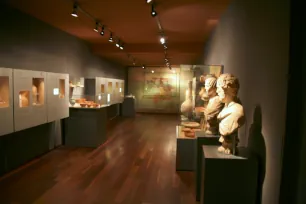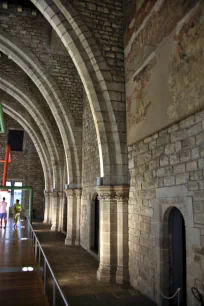The Museu d’Historia de la Ciutat is a museum that narrates the history of Barcelona from its early beginnings to its heyday in the Middle Ages. Its main draw is an underground ruin with the remains of Roman buildings.
Casa Clariana Padellàs



The museum is housed in the Casa Padellàs, a fifteenth-century Gothic palace that in 1931 was transported stone by stone from its original location on the Carrer dels Mercaders to the Plaça del Rei.
The palace has a typical Catalan Gothic architecture, with a small inner courtyard and external staircase. During the excavation work necessary to build the new foundations for the palace, remains of the old Roman city were uncovered. From 1930 until 1960 a large area, stretching under the Plaça del Rei, was excavated. To better preserve these remains, it was decided to move Barcelona’s city museum to this site, and the museum opened here in 1973.
The museum’s exhibitions are displayed in chronological order, starting on the ground floor of the Casa Padellàs where several small rooms show the prehistory of the Plain of Barcelona.
Barcino
An elevator brings visitors to an underground level where you’ll find the remains of the Roman city of Barcino, founded around 12 BC by emperor Augustus. The underground section covers an area of about four thousand square meters, stretching as far as the cathedral.
Following the walkways you will see the remains of a laundry and dying workshop from the second century, a salted fish and garum factory (garum was a popular fish sauce) and even a wine making facility from the third century AD. With the help of videos, diagrams, models, mosaics and small objects, the ruins give visitors an idea of daily life in Barcino.
There are also ruins from a later period, including a church from the Visigoth period (sixth century) and the episcopal complex, built between the fourth and seventh century AD.


Palau Reial
Back upstairs, you end up at the Palau Reial Major, a royal complex built in the fourteenth and fifteenth centuries. Here the museum has a series of displays that tell the history of Barcelona during the Middle Ages, from the eight until the thirteenth century, when the city experienced rapid growth. The tour concludes with a visit to the St. Agatha Chapel and the Tinell Hall.
The Saló del Tinell (Tinell Hall) was built between 1359 and 1370. The hall measures 33.5 by 17 meters (110 x 56 ft) and has seven arches supported by large buttresses that are clearly visible from the Plaça del Rei. Wall paintings from the late thirteenth century depict the conquest of Mallorca by king Jaume I.
The hall was used as a throne room and important guests were invited here. Christopher Columbus is said to have reported his discovery of America here to king Ferdinand and Queen Isabella. Today the hall is used for temporary exhibitions.
The nearby Capella Reial de Santa Àgata (St. Agatha Chapel) was built in 1302 on top of the Roman wall that surrounded Barcino. The chapel has a single nave with a wooden ceiling. The apse is decorated with a magnificent retable that was created in 1465 by Jaume Huguet.

